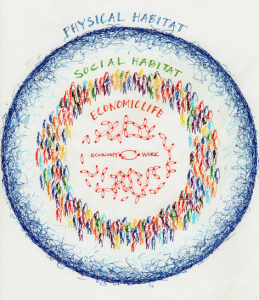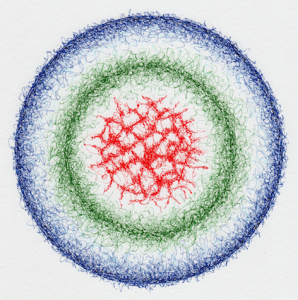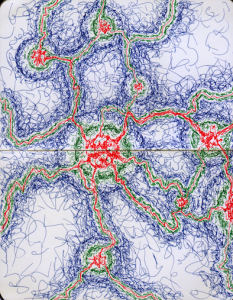The staggering rate of population and city growth alone are enough for me to recognize that something, at some point, is going to give. We are going to have to adjust to something. And given the rate of change, we are going to have to learn how to adjust quickly. That means we have to welcome change, quickly examine what adjustments are necessary, and take timely, appropriate action. Debating whether or not something is happening, such as green house gas emissions, is a distraction from what we need to do: learn how to organize ourselves to be adaptable. Adaptability will ensure we survive and thrive and, as it turns out, adaptability is what got us here in the first place.
(This post concludes a series of 14 posts that constitute my first efforts to blog my book, Nest City: The Human Drive to Thrive in Cities. For readers wanting to go to the first post, here is a link. These first posts assemble into Chapter One: The City Impulse.)

There is within us an evolutionary impulse to do more than merely survive. At the core of this impulse is our work – the efforts we make to innovate and find new ways of thinking, making and doing new things. And this impulse to innovate generates cities (and cities generate innovation too). Developing cities, then, is a survival skill. And the role of our work – and our approach to our work – in cities can not be understated because it creates cities. All of this happens in the context of our physical habitat (see Figure A). Our ability to evolve, along with our cities, is a survival skill.
The dynamic relationship between our economic life – our work – and our habitat is only as healthy as the feedback that flows back and forth. Cities are, in fact, a result of this relationship. In this dynamic, our social habitat is the conduit between our economic life and our physical habitat. It is the sphere where we allow, or disallow, connections to be made between our economic life and our physical habitat. It is where we create the conditions individually and collectively to notice what is happening around us and integrate our world with our work, our work with our world. Or, more appropriately, where we integrate our cities with our work, our work with our cities. Our cities need quality feedback.
Innovation hinges on looking at things in new ways, but it is the innovative quality of our work in the context of our habitat that drives whether a city declines or thrives, not just the fact that we are innovative. More of the same work – without innovation and adaptation – makes us busy, but it does not mean we learn and grow. More and more new work, for the sake of innovation, does not mean we adapt either. Innovation in the context of our life conditions, which are constantly changing, means we adapt – and evolve. Innovation + adaptation means we are thinking, making and doing new things. This is a critical understanding in light of the challenges we face as a species with a quickly growing population.
As citizens we have choices about the work we do and our awareness of whether the work we do is responsive to our life conditions. We must be brave enough to look at life conditions, let alone acknowledge them. We must be brave enough to notice what is happening and to respond appropriately. This bravery is needed at many scales – in citizens, in organizations, in cities, in society. How do we create the conditions for this kind of courage?

Jane Jacobs suggested that it is sensible to foster desirable new work and select from those worth fostering further. Our evolutionary path isn’t about simple generating more and more and more new work, endless innovating. The word ‘select’ implies that someone will do the selecting and that we know the criteria to choose the work that will work. But we will never have criteria for this kind of work because we have never been here before. Each moment ahead of us is new, and the criteria we have used for previous situations are criteria for previous situations – not the present or the future. But it is a far more diffused, yet simple, process than that. We need to know the direction we face and we need to ‘notice’ what works along the way, to get us there.
The work ahead of us is about creating cities – our habitat – that allow us to change the work we do and how we go about doing it. It is about creating cities, right now, that work for us. The challenge is recognizing that our work, whether paid or unpaid, and our desire to improve our work is an innovation-generating evolutionary impulse. This impulse is the force that creates and recreates cities, which in turn creates the conditions for further innovation. We shape the city and in return it shapes us. We build the nest that nurtures us. It is time to notice how we go about organizing ourselves to get what we need from this relationship.

We have never been here before. We are at a point in time unlike any other and our efforts to understand the world in the ways we have always tried to understand the world are not accurate. We face together a world full of uncertainty and unpredictability. Any actions we take as individuals and as collectives have unexpected ripple effects in ways we can not contemplate or anticipate, which means that each of us is connected to others in significant and unimaginable ways. We are in this experiment of humanity together. To be dynamically stable – to steer well – we need to be willing to receive feedback and we need to explicitly seek feedback, even if it is telling us information we do not want to hear. We need this feedback to do our work well, and our cities need this feedback as well. We simply need to be awake to notice things around us.
This will take great courage, because to invite honest feedback is to invite hearing that we are not getting the results we would like. It is time for us to organize ourselves in such a way that we are clear about our destination, that we provide ourselves with the support we need to be courageous enough to be awake on the journey, and we create the conditions for success within our world of unpredictability by self-organizing so the best possible way forward will emerge. It is time to consciously create our nest city. It is time to jump into the driver’s seat of our own evolution.
The next series of posts will revolve around what it means to plan our cities. Are cities really planned? What patterns can be discerned in how we go about creating our cities? The dynamic that generates cities is not linear, yet our current efforts in North America to create sustainable cities are limited to linear approaches. The next round of posts will make the case that a new way of designing for cities that serve their citizens well is emerging. You can aid an abet its emergence by exploring these questions:
What can my city do for me?
What can I do for my city?
What can our city do for us?
What can we do for our city?
Note –
For those interested in exploring the preceding posts that form Chapter One: The City Impulse, here they are in order:
- Are people growing cities or are cities growing people?
- Driven to do more than merely survive
- Cities are engines of innovation
- The development of cities is a survival skill
- The work we do creates our cities
- Evolving cities is a survival skill
- Be a part of feedback loops in your city
- Cities: the result of our evolving interaction with our habitat
- Cities need quality feedback from habitat
- Dynamically steering cities into the future
- Work at scale to serve the city
- Inter-city tournaments
- The city as a nest